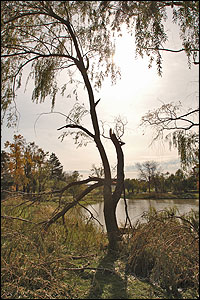Archives
UB hires arborists to assess tree damage
By SUE WUETCHER
Reporter Editor
The university has hired two certified arborists to help assess the damage to trees on the North and South campuses due to the freak October snowstorm.

Assessing damage to trees like
this on the UB North Campus will be the chief task of two certified arborists hired
by the university.
PHOTO: NANCY J. PARISI
Richard Steadman of Wright-Frontier Tree & Lawn Care has begun assessing the damage to trees, focusing first on safety, says John P. Hayes, assistant director for buildings and grounds, University Facilities. Bill Snyder of Lakeside Sod and Nursery will begin work the second week of November.
"They will assure that any hazardous conditions are mitigated and then focus on the appropriate steps to take to prune and assure the long-term health of the trees," Hayes says.
He estimates that of the approximately 8,500 trees on the two campuses, 65 percent to 70 percent have been damaged to some degree. However, he expects that less than 1 percent of the 8,500 trees will have to be taken down as a result of damage from the storm.
"A few trees were taken down immediately after the storm because of an imminent danger of the trees falling on pedestrians or cars," Hayes says, adding that any decision to take down additional trees will be a joint one made by the arborists, University Facilities and the Environmental Task Force.
He notes there is no specific plan in place yet to replace the trees, "mostly because we don't yet know the number of trees to be replaced." He points to University Facilities' policy that any tree that is removed is replaced at least on a 1 to 1 replacement basis. "In many cases, we plant two or three trees for each tree that comes down," he explains, although the replacements may not always be in the same place or the same variety of tree as the one being replaced.
"We will follow this same policy for storm-related tree losses," he says.
Hayes notes that all new plantings will be selected from a list of native/indigenous trees that is part of the university's master landscape plan.
Most of the replacement trees will be planted in the spring, he adds.
